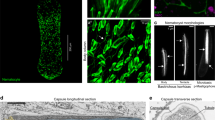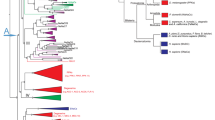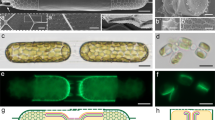Abstract
Nematocysts are the stinging organelles of jellyfish, sea anemones and other cnidarians. Each one consists of a closed capsule filled with fluid. In the resting state, part of the surface of the capsule is inverted, forming a tubular thread, which is everted explosively on excitation. The mechanism of explosion is not yet understood1–3; it may be relevant to exocytosis in general, as the nematocyst is a specialized type of exocytotic secretion originating in the Golgi apparatus4. Picken and Skaer1 observed that the capsular fluid showed a large depression of freezing point, suggesting that the osmotic pressure might be as high as 140 bar. They tentatively ascribed the explosion to a sudden increase in permeability of the capsule wall, allowing a rapid osmotic influx of water. However, there is evidence that the material of the thread itself may be capable of some degree of extension5,6 and it has been suggested that osmosis plays no part in discharge3. We present here a new theory: that the capsule wall is permeable to water even in the undischarged state; discharge is initiated by an increase in the osmotic pressure of the capsular fluid which is brought about by removal of bound calcium ions.
This is a preview of subscription content, access via your institution
Access options
Subscribe to this journal
Receive 51 print issues and online access
$199.00 per year
only $3.90 per issue
Buy this article
- Purchase on Springer Link
- Instant access to full article PDF
Prices may be subject to local taxes which are calculated during checkout
Similar content being viewed by others
References
Picken, L. E. R. & Skaer, R. J. Symp. zool. Soc. Lond. 16, 19–50 (1966).
Robson, E. A. Publ. Seto mar. biol. Lab. 20, 653–673 (1973).
Mariscal, R. N. in Coelenterate Biology: Reviews and New Perspectives (eds Muscatine, L. & Lenhoff, H.) 129–178 (Academic, London, 1974).
Skaer, R. J. J. Cell Sci. 13, 371–393 (1973).
Robson, E. A. Q. Jl microsc. Sci. 94, 229 (1953).
Carré, D., J. Cell Biol. 20, 265–271 (1980).
Wolf, A. V. Aqueous Solutions and Body Fluids: Their Concentrative Properties and Conversion Tables (Harper & Row, New York, 1966).
Sernetz, M. & Schmidt, H. Microsc. Acta 73, 109–116 (1973).
Ross, K. F. A. Phase Contrast and Interference Microscopy for Cell Biologists (Edward Arnold, London, 1967).
Lubbock, R., Gupta, B. L. & Hall, T. A. Proc. natn. Acad. Sci. U.S.A. (in the press).
Blanquet, R. Comp. Biochem. Physiol. 35, 451–461 (1970).
Author information
Authors and Affiliations
Rights and permissions
About this article
Cite this article
Lubbock, R., Amos, W. Removal of bound calcium from nematocyst contents causes discharge. Nature 290, 500–501 (1981). https://doi.org/10.1038/290500a0
Received:
Accepted:
Issue Date:
DOI: https://doi.org/10.1038/290500a0
This article is cited by
-
Puncture mechanics of cnidarian cnidocysts: a natural actuator
Journal of Biological Engineering (2009)
-
Envenomation by the box-jellyfish Chironex fleckeri: how nematocysts discharge
Hydrobiologia (1991)
-
The spatial distribution of cations in nematocytes of Hydra vulgaris
Hydrobiologia (1991)
-
Discharge of nematocysts isolated from aeolid nudibranchs
Hydrobiologia (1991)
Comments
By submitting a comment you agree to abide by our Terms and Community Guidelines. If you find something abusive or that does not comply with our terms or guidelines please flag it as inappropriate.



